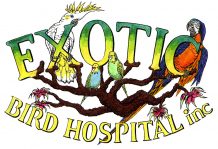
Biological Facts
The sugar glider is native to eastern and northern mainland Australia, and was introduced to Tasmania. The sugar glider is also native to various islands in the region.
- Sugar glider (Petaurus breviceps)
- Tree-dwelling, nocturnal marsupial from Australia and New Guinea
- Diet during the spring and summer months consists almost entirely of insects and other prey items; diet during the fall and winter consists of eucalyptus sap, acacia gum, nectar, and manna (sap that oozes from wounds on trees)
- Live in large family groups (colonies) of 15-30 individuals
- Males have a scrotal sac located on the abdomen, where you would expect the belly button to sit; it looks like a little pom-pom. They also have a bifurcated (forked) penis. At maturity, intact males develop oily bald spots (scent glands) on their forehead and chest. Neutering prevents this.
- Females have a “U”-shaped opening on the abdomen, where you would expect the belly button to sit. This opens into the pouch (marsupium) where the babies develop and contains two teats.
- Extremely social animals, best kept in groups of 2 or more
- Solitary gliders require a lot of attention from their owners!
- Prone to behavioral problems if housed alone
- Best time to adopt/socialize is when joeys are 7-12 weeks out of pouch
- Very vocal: “crabbing” when excited, “bark” or “chatter” for attention
- Scent marking behavior allows recognition by group members
- Intact males mark their cages with urine. Neutering reduces this tendency.
- Breed readily in captivity
- BML (recipe below) or commercial diet for insectivore/carnivore (e.g. cat food kibble)
- Need fresh fruits and vegetables (NOT canned, dried, or trail mix) such as chopped apple, mango, grape, carrot, sweet potato, etc.
- Heavily insectivorous – supply gut loaded crickets, mealworms, waxworms, moths
- Require ~50% protein in diet supplied by insects, lean boiled chicken or turkey, scrambled egg, cottage cheese, yogurt
- Fresh foods and insects can be dusted with mineral supplements such as Repcal or Herptivite, supplements such as Glideraide, Supreme blend, or Lory nectar may also be offered
- Because of their social nature, pet gliders should always be kept in pairs or small groups. Fighting is rare; same- or mixed-gender groups are usually fine.
- Require large cages (minimum 2 cubic feet, should be as large as possible)
- Wire caging best with mesh size no larger than ½” to ¾”
- Require non-toxic branches (manzanita, apple, citrus) for perching, chewing, exercise
- Need pouches or nest boxes near the top of the enclosure for resting, hiding
- Use aspen or paper bedding – avoid cedar and pine as these can cause respiratory problems
- Environment should be draft free, 70-90°F (21.1-32.2°C), NOT placed in bright sunlight!
- Keeping the cage/bedding very clean will help prevent odor and behavioral problems such as self-barbering and self-mutilation
- Routine physical examination every 6 to 12 months
- Consult a veterinarian with experience treating exotic pets if you have any questions or concerns about your sugar glider’s health.
- Annual fecal examination for parasites
- Blood tests as recommended by your veterinarian
- Neutering males prevents development of prominent scent glands
- Toenails require regular trimming
- No vaccines are required
- Malnutrition and its consequences
- Hind limb paralysis, tremors, rickets, cataracts, blindness
- Stress-related diseases
- Self-mutilation, pulling or chewing fur, pacing, eating disorders, cannibalism of young, abnormal aggression
- Pneumonia
- Diarrhea
- Internal parasites
½ cup honey (do not use honeycomb, raw or unfiltered honey)
1 hard boiled or scrambled egg with the shell
¼ cup apple juice (not frozen or for babies)
1 (4 oz) bottle premixed Gerber juice with yogurt (mixed fruit or banana)
1 teaspoon Rep-Cal Herptivite vitamin supplement
2 teaspoons Rep-Cal Calcium supplement (non-phosphorous with Vitamin D3)
2 (2 ½ oz) jars Stage 1 or 2 Heinz, Gerber, or Beechnut chicken baby food
¼ cup wheat germ
½ cup dry baby cereal (Heinz or Gerber, mixed or oatmeal)
Blend the first three ingredients together until well mixed. Add the remaining ingredients and blend well. Pour into ice cube trays and freeze (1 cube is approximately 2 tablespoons). Good for 1 month.
Recommend daily diet for one sugar glider:1 tablespoon BML
1 tablespoon chopped fruits
1 tablespoon chopped vegetables
3-5 insects
